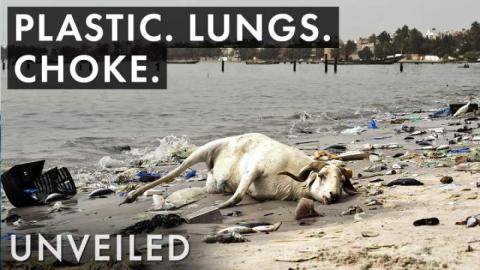What Happens When Plastic Pollution Gets Worse?

advertisement
VOICE OVER: Noah Baum
WRITTEN BY: Derick McDuff
Plastic pollution is now considered a major threat to the Earth's environment. Plastic waste and microplastics are a serious danger to ocean habitats, the natural world and even our own health. But, what if the situation gets even worse? What happens if the mountains of plastic in landfill (and the floating islands of plastic in the sea) continue to grow?
What If Plastic Pollution Gets Worse?
Plastic pollution is one of the biggest environmental issues our planet faces today. Plastic slush fills our oceans, plastic trash litters our landscapes, and even the air we breathe has microscopic pieces of plastic polluting it.
This is Unveiled and today we’re answering the extraordinary question; What if plastic pollution gets even worse?
The problem with plastic is that, most of the time, it never fully disintegrates - often, it’s specifically designed that way. And, given that many plastic products are single-use items, we’re producing more and more and more of a material that’ll never ‘go away’. True, some plastics can be recycled, but that doesn’t mean that everyone does so - leaving wrappers, water bottles, pieces of packaging and everything else to clog up ecosystems.
Around eight million tons of plastic winds up in the ocean every year. It’s predicted that this type of pollution will triple in the next decade, and that by 2050 there could even be more plastic in the water than fish. Which is devastating news for all marine life, with aquatic creatures either mistaking plastic for food and ingesting it, or getting trapped in casually discarded human trash. According to recent figures, almost half of marine vertebrates were wiped out between 1970 and 2012… but if plastic use continues as it has done, the stats will get worse. We’ll see entire species forced to extinction, and increasingly severe knock-on effects across the food chain as predators consume plastic via their prey.
The amount of plastic in the ocean is now so immense that at least five huge garbage islands have formed around the world. Made up only of the more buoyant plastics, these floating trash heaps are set to grow and grow. The Great Pacific Garbage Patch is the largest of all. Also known as the GPGP, it floats between California and Hawaii and takes up an area twice the size of Texas - holding around 1.8 trillion pieces of plastic, including some dating back to the 1970s. And remember, these patches are only made up of plastic on the ocean’s surface. It’s estimated that 99% of all plastic in the water is unaccounted for below the waves, and these often-smaller pieces pose an even more sinister threat.
At five millimeters long or less, microplastics are small enough to go unnoticed to the human eye, but these tiny particles (that never truly break down like organic matter does) can remain in the sea for centuries. It’s no longer a ‘mistake’ on behalf of the fish to eat this type of plastic, but an unavoidable accident. In fact, microplastics are so small, they can be absorbed into an animal’s body simply through respiration - or even via tiny plankton carriers. Again, microplastics can make their way up the food chain even as far as seafood-eating humans - so plastic pollution directly impacts human health.
And it’s not only the oceans we should worry about, either. Landfills overflowing with plastic are concerningly ‘normal’ nowadays. And, as these areas encroach into other natural environments, the spread of non-biodegradable litter widens. It can even affect our drinking water supply, with plastics leaching toxic chemicals into the groundwater in some areas. At the very least, these materials wind up in rivers, and eventually end up in the oceans again.
Finding a solution to the issue (beyond simply not using plastic) is a problem, too. Simply incinerating plastic is plain dangerous for anyone nearby, and more broadly speaking it contributes to air pollution, the depletion of the ozone layer and climate change. And it throws microplastics into the air, inflicting on us the same problem that sea animals face - meaning every breath you take risks microplastics in your lungs, possibly your bloodstream and eventually other parts of your body.
Completely cleansing the environment of the plastic that’s already here currently seems an almost impossible task, that will at least take a very long time. But, preventing the problem from getting worse is doable. It rests on changing habits, increasing recycling and reducing our reliance on plastic in general, both individually and as a society.
Right now, plastic pollution stretches to almost every corner of Earth. But, as long as it’s mass-produced and irresponsibly disposed of, the garbage heaps, landfills and floating islands of yesterday’s trash will continue to grow, and the negative effects will continue to pile up. And that’s what will happen if plastic pollution gets worse.
Sign in
to access this feature
